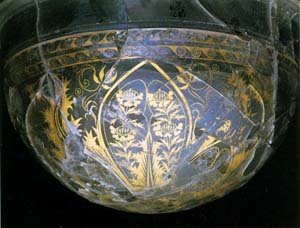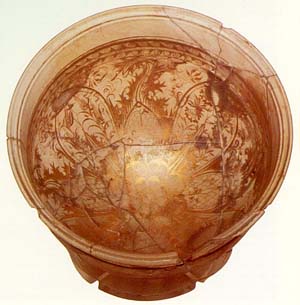The bowl of Canosa
 This
fabulous piece of art was found in Canosa, Italy. It has been dated to 3rd
century BC. The provenance isn't able to be proven however it has been speculated
in may have originated from Egypt. Wherever it came from, it is testament
to the level of craftsmanship in working glass at the time.
This
fabulous piece of art was found in Canosa, Italy. It has been dated to 3rd
century BC. The provenance isn't able to be proven however it has been speculated
in may have originated from Egypt. Wherever it came from, it is testament
to the level of craftsmanship in working glass at the time.
The techniques used differ from the reverse giding and painting you see on this site but it is a valuable pre-cursor and a fine example of the beauty of gold with glass.
It was made using two bowls, very finely ground so that one fits perfectly inside the other. The decorative gilding is sandwiched inbetween. The design in the gilding is formed by applying the gold to one bowl, engraving it to remove unwanted areas of gilding and then fitting the bowls together with the gold sandwiched inbetween.
 The
sandwich idea was later rediscovered and led to the 18th century zwischengoldglas, seen at it's peak in the glassware from Bohemia. The Roman gold glasses of the 4th century share many similarities but are made by a different method.
The
sandwich idea was later rediscovered and led to the 18th century zwischengoldglas, seen at it's peak in the glassware from Bohemia. The Roman gold glasses of the 4th century share many similarities but are made by a different method.



